By Ariana Zarleen / Burma Link
Nagaland was once a free land with rich and unique cultural traditions that varied from village to village, each village ruled by their own chieftains. The faith of the Naga took an ugly turn after the British divided Nagaland without the consent or knowledge of the Naga who refused to acknowledge an arbitrary borderline that ran through villages, fields, and even homes. After the British left, Indian and Burmese forces occupied Naga homeland, following an agreement by their leaders that the Western part of Nagaland was to be ruled by India and Eastern part by Burma. The Nagas never succumbed to the foreign occupation – Naga warriors have now been fighting a desperate struggle for freedom and sovereignty for over six decades. In this rare in-depth interview, W. Shapwon, an Eastern Naga leader and Joint Secretary of the Naga National Council, reveals the troubling history and current issues of Naga Hills and talks about the dreams of the Naga nation.
[/fusion_fontawesome]They called us the free Naga
Nagas are from Mongolian racial group, like Kachin, Kayin, Kayah, Chin. We are the same. So with our migration history, we have the same route, from Mongolia to Tibet, and Tibet to China. So we are the same racial group with the Mongolian people.
We have been living as free people, we had no government, we had no king, but chieftains ruled the villages. So in the past, villages were independent villages. No police was needed to enforce law, so we were living as free people. We didn’t know about Burmese kings, we didn’t know about Indian kings, we didn’t know any other kings. We were ruled by our chieftains.
The British colonial regime reached our land in 1832. They first reached Western part of Nagaland. That’s when people started interacting with the British. Eastern Nagaland, they didn’t reach until after 1930 maybe. Then they visited some parts of eastern area. But they didn’t annex our area. They called us the free Nagas.
In the Western part, Christianity reached in 1876 and education also started from there. So people in Western Nagaland became more advanced. They
[people in Western Nagaland] said we [Naga] are free people, and we have a right for self-determination. They officially submitted the document to the British in 1929, saying that leave us alone to determine by ourselves as in the ancient times. The memorandum was written and submitted to the British government by the Naga Club, which was formed already in 1918. Based on that memorandum the Naga National Council (NNC) was formed in 1946.
[/fusion_fontawesome]Before India and Burma were granted independence, the Nagas declared independence to the outside world
Before our people were not organised as a nation. But after the formation of Naga National Council, all the villages of free Nagas were brought into a nation. The Naga national family stood to preserve and protect the sovereignty of Nagaland, and the Naga National Council clearly stated in a memorandum to the British that the Naga will remain as an independent nation. Without our knowledge, our nation should not be turned into the political sphere of India. It was stated and submitted to the British government.
Before India and Burma were granted independence, the Nagas declared independence to the outside world. We did it because we wanted to safeguard our future, our sovereignty. If not, the world would not know that Nagas are sovereign people.
So the British had no right to say that they handed over the Nagaland into Burma or India. We had already clearly stated to them our sovereignty in 1929 and following up in 1946-47. We clearly stated that Naga will remain an independent nation.
In 1951, the declaration of independence was reaffirmed by 99.9% of Naga people on May 16, when the NNC conducted a Plebiscite. The people’s verdict was to remain independent as in the ancient times, and immutable mandate was given to NNC to speak for the Naga people.

A meeting hall of the Federal Government of Nagaland (FGN), in Kohima, Nagaland Capital City. The Federal Authorities are in a process of meeting. The FGN was formed on March 22, 1956, under the aegis of the NNC. (Photo: NNC)
[/fusion_fontawesome]How can the British give our land to other nations, without our knowledge?
After Burma and India got their independence, they became free from the orders of colony. Since 1954, they started to colonise our country. That is when the war started. India started the war with the Nagas. We didn’t go to India, but they sent their armed forced to Nagaland and started fighting with the Nagas. So the war started between us. It is dragging on, unsolved, till today.
India and Burma had no right to invade Nagaland. They had no right to colonise Nagaland again. They themselves bitterly fought against the British colonialism. After they break from the British colony, how can they use the same colonialism against the Naga? They have no right to suppress the Naga people. They have no right to deprive the right of Nagas to be a nation. And the British had no right to give our land to India or Burma without our consent, without our knowledge.
In the Atlantic Charter from 1943, UN Charter, they say that no people or land shall be transferred to other nation without the people’s consent. That was made also by British and American people. So how can the British give our land to other nations, without our knowledge? Because of this war we have lost many lives. And the British are not attempting to solve the problem.
The problem started after the British left this Indian subcontinent. If British make clear our position, according to our memorandum submitted to them, then there should be no problem. But the British have failed to do that. In the Second World War the Naga helped their land forces a lot, to fight against their enemy. We have done a lot to help them. But instead of trying to help us, when India or Burma are giving us trouble, they quit. Karen also, Kachin also speaking in that way, the same thing. We feel bad.
[/fusion_fontawesome]Our country is occupied, our lands are not developed
Our NNC President submitted a memorandum to the UN in 1960 October. Our leaders asked for intervention by the UN in the atrocities committed by India against the Naga. But the UN did not attempt to intervene in the war. After that India started playing divide and rule policy. They started attempting to internalize the Indo-Naga conflict in the eyes of the international community.
The UN and the world community should help our people, should support our rights. We are not demanding anything from India. We are not demanding anything from Burma. It is our land. Before Burma became independent, and India, we talked to the leaders. We talked to Aung San and Mahatma Gandhi. They agreed that Nagas have every right to be independent. But after they [Burma and India] got independence they became our enemy, to fight against us. We don’t want to fight them! We want to be good neighbors with them. We are not their enemy.
If only they did not suppress us and keep us in the dark… The Nagas may have developed. But now, our country is occupied, our lands are not developed, our people are not developed.
[/fusion_fontawesome]I sleep in Burma, eat in India
NNC represents all Naga people. One Nagaland for Naga people. We think that the British had no right to draw the borderline in the heart of Naga country. The British are so far away from our country. How can they come and draw our border without our knowledge? Because of this border, if our home is in India, our fields in Burma, our kettle going around India and Burma. And this local village, Lungwa village, is divided into two parts. So Lungwa villagers have become two nations’ citizens. The village chieftain says that “I sleep in Burma, eat in India”. Because the border crosses in the middle of his house. How can we recognise that as a border?
If Gandhi and Aung San had lived, it might be different. Their successors arrogantly invaded our country. Nehru on India’s side and U Nu on Burma‘s side. U Nu and Nehru visited Nagaland on March 30, 1953. That day they came to Nagaland on their own initiative. Though they were not invited by the Naga people, our Naga leaders and Naga people prepared to request them to recognise the sovereignty of Nagaland, on that day. But at the beginning of the meeting it was announced that no Naga will be allowed to meet these two prime ministers nor to submit the memorandum to them. In protest, the Nagas walked out en mass to the last man.
Nehru disappointed the Naga people, and in April 1953, the Government of India started ruthless political persecution, including mass arrests, torture, and terrorizing against the Nagas. On April 13, 1953, the Indian Government even gave instructions to the Indian Armed Forces in Nagaland to rape Naga women. A letter of protest was subsequently sent to the Prime Minister of India against this abominable instruction.
And we heard that after the meeting Nehru and U Nu flew to Khamti and agreed to control Nagaland; Eastern part of Nagaland to be controlled by the Burmese, and Western part by India. Without our knowledge! They had no right to do that.
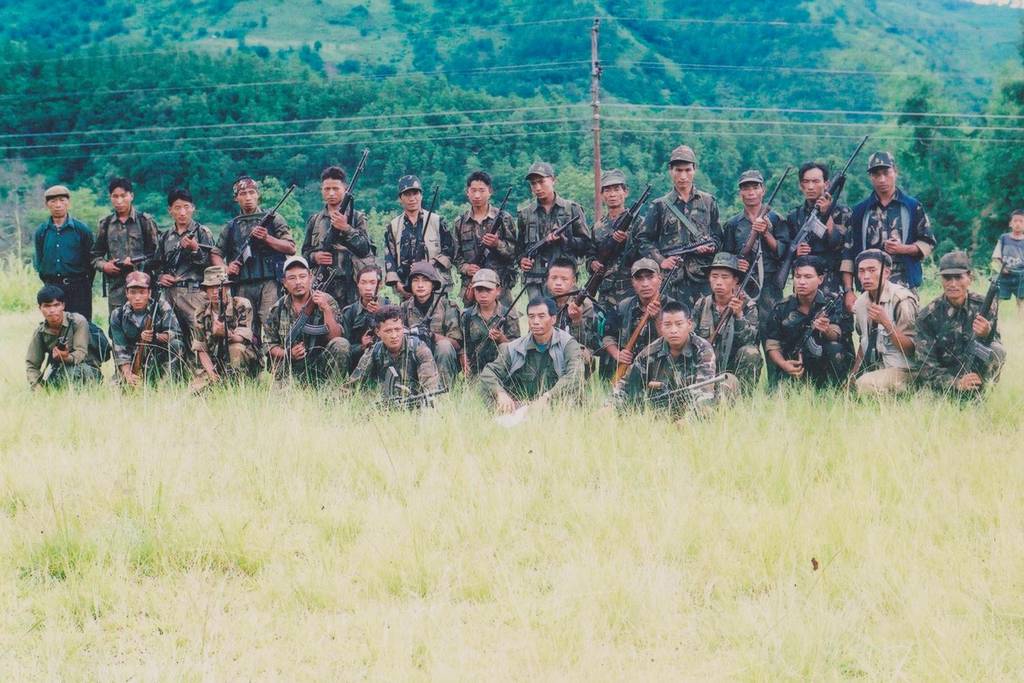
Naga Army soldiers. Naga Army was formed in the 1950s when the Indian Army started undeclared war with the Nagas. (Photo: NNC)
[/fusion_fontawesome]India and Burma; we don’t want your occupation of our land!
Many of the world people don’t know the back of the conflict. They say Nagas are on the wrong or hostile or this and that, but we’re not hostile, we’re not on the wrong!
We want to say to the world community that we want the support of the world community. Now in the world, many people are guarding and respecting human rights. The Burmese and Indian people are smart and civilized people, so they should nobly allow us to be a nation. The Nagas are a nation, and we will be a good neighbor with Burma and India.
For more than 60 years now we have been suffering. International community should acknowledge that Nagas are sovereign people. We want to say to India and Burma; we don’t want your occupation of our land! We have nothing to negotiate with them, but we just say withdraw your occupational forces from our country. Nagas are a free people. We did not sign to join Indian Union. We did not sign to join the Burmese either.
Even animals should not be kept in a cage. They should be free! In the free world. In Belgium, a few months ago, I think one zebra was killed and fed to the tigers and lions. The people said you shouldn’t deprive the animal of its rights. The value of human is more than an animal isn’t it? So why the Burmese and Indian can kill us freely, we don’t know.
[/fusion_fontawesome]Foreigners are not allowed to enter the Naga villages
Not much has changed in Eastern Nagaland since reforms [in Burma]. Now they say they are constructing roads and things like that. But mostly, the people are forced to work on the road, without payment. For example, a road was constructed between Lahe and Khamti maybe for more than 50 years. But even now, the road is not good. In the dry season they call the villagers; take your ration for one month, work on the road! The villagers are getting the stones from the river, for the road. Next year again they come and call the people. All these things are still happening. Some say the money to construct the road is going in the pockets of the Burma Army officers.
Many many human rights violations are there! But no organisations are there to report it. Raping, beating, illegally collecting money, threatening the people and taking their money or their domestic animals, cows, and pigs. All these things demanded by the Burmese army officers. Without payment all these things. [Read more about human rights violations in the Naga Hills in the report by Naga Youth Organization in 2010]
There is also religious persecution. They are forcefully converting the Naga Christian into Buddhist (click here to read more). Those who convert into Buddhism, they give them money and rice. They are giving more facilities to Buddhist Naga. If they have constructed a boarding house for the students, they will say no Christians are allowed. Christians are not allowed to stay in the boarding house, only Buddhist. And also for army training, no Christian is allowed. They only accept Buddhists. And no official will be promoted to higher rank if he is not Buddhist. If he wants to become an officer, he should deny Christ. Right now it is going on.
Foreigners are not allowed to enter the Naga villages. They are only allowed to come to the New Year festival, which is always during January. Foreigners are allowed to come there because they give more money to the Burmese army officers. But they are not even allowed to talk with the Naga people.
Naga New Year Festival photos (photo credit: NNC)
[/fusion_separator]
This story is based on Shapwon’s voice as he tells Burma Link about Naga history and current issues.
Coming soon: Shapwon’s personal story and the incredible struggles he has been through to help his people.
Further reading: Naga Youth Organization (NYO) (2010). Life under Military Rule: Human Rights Violations of Nagas in Burma. A report by the Naga Youth Organization, Burma. Published in October 2010
You may also like:
Nagas are from Mongolian racial group, like Kachin, Kayin, Kayah, Chin. We are the same. So with our migration history, we have the same route, from Mongolia to Tibet, and Tibet to China. So we are the same racial group with the Mongolian people.
We have been living as free people, we had no government, we had no king, but chieftains ruled the villages. So in the past, villages were independent villages. No police was needed to enforce law, so we were living as free people. We didn’t know about Burmese kings, we didn’t know about Indian kings, we didn’t know any other kings. We were ruled by our chieftains.
The British colonial regime reached our land in 1832. They first reached Western part of Nagaland. That’s when people started interacting with the British. Eastern Nagaland, they didn’t reach until after 1930 maybe. Then they visited some parts of eastern area. But they didn’t annex our area. They called us the free Nagas.
In the Western part, Christianity reached in 1876 and education also started from there. So people in Western Nagaland became more advanced. They
[/fusion_fontawesome]Before India and Burma were granted independence, the Nagas declared independence to the outside world
Before our people were not organised as a nation. But after the formation of Naga National Council, all the villages of free Nagas were brought into a nation. The Naga national family stood to preserve and protect the sovereignty of Nagaland, and the Naga National Council clearly stated in a memorandum to the British that the Naga will remain as an independent nation. Without our knowledge, our nation should not be turned into the political sphere of India. It was stated and submitted to the British government.
Before India and Burma were granted independence, the Nagas declared independence to the outside world. We did it because we wanted to safeguard our future, our sovereignty. If not, the world would not know that Nagas are sovereign people.
So the British had no right to say that they handed over the Nagaland into Burma or India. We had already clearly stated to them our sovereignty in 1929 and following up in 1946-47. We clearly stated that Naga will remain an independent nation.
In 1951, the declaration of independence was reaffirmed by 99.9% of Naga people on May 16, when the NNC conducted a Plebiscite. The people’s verdict was to remain independent as in the ancient times, and immutable mandate was given to NNC to speak for the Naga people.

A meeting hall of the Federal Government of Nagaland (FGN), in Kohima, Nagaland Capital City. The Federal Authorities are in a process of meeting. The FGN was formed on March 22, 1956, under the aegis of the NNC. (Photo: NNC)
[/fusion_fontawesome]How can the British give our land to other nations, without our knowledge?
After Burma and India got their independence, they became free from the orders of colony. Since 1954, they started to colonise our country. That is when the war started. India started the war with the Nagas. We didn’t go to India, but they sent their armed forced to Nagaland and started fighting with the Nagas. So the war started between us. It is dragging on, unsolved, till today.
India and Burma had no right to invade Nagaland. They had no right to colonise Nagaland again. They themselves bitterly fought against the British colonialism. After they break from the British colony, how can they use the same colonialism against the Naga? They have no right to suppress the Naga people. They have no right to deprive the right of Nagas to be a nation. And the British had no right to give our land to India or Burma without our consent, without our knowledge.
In the Atlantic Charter from 1943, UN Charter, they say that no people or land shall be transferred to other nation without the people’s consent. That was made also by British and American people. So how can the British give our land to other nations, without our knowledge? Because of this war we have lost many lives. And the British are not attempting to solve the problem.
The problem started after the British left this Indian subcontinent. If British make clear our position, according to our memorandum submitted to them, then there should be no problem. But the British have failed to do that. In the Second World War the Naga helped their land forces a lot, to fight against their enemy. We have done a lot to help them. But instead of trying to help us, when India or Burma are giving us trouble, they quit. Karen also, Kachin also speaking in that way, the same thing. We feel bad.
[/fusion_fontawesome]Our country is occupied, our lands are not developed
Our NNC President submitted a memorandum to the UN in 1960 October. Our leaders asked for intervention by the UN in the atrocities committed by India against the Naga. But the UN did not attempt to intervene in the war. After that India started playing divide and rule policy. They started attempting to internalize the Indo-Naga conflict in the eyes of the international community.
The UN and the world community should help our people, should support our rights. We are not demanding anything from India. We are not demanding anything from Burma. It is our land. Before Burma became independent, and India, we talked to the leaders. We talked to Aung San and Mahatma Gandhi. They agreed that Nagas have every right to be independent. But after they [Burma and India] got independence they became our enemy, to fight against us. We don’t want to fight them! We want to be good neighbors with them. We are not their enemy.
If only they did not suppress us and keep us in the dark… The Nagas may have developed. But now, our country is occupied, our lands are not developed, our people are not developed.
[/fusion_fontawesome]I sleep in Burma, eat in India
NNC represents all Naga people. One Nagaland for Naga people. We think that the British had no right to draw the borderline in the heart of Naga country. The British are so far away from our country. How can they come and draw our border without our knowledge? Because of this border, if our home is in India, our fields in Burma, our kettle going around India and Burma. And this local village, Lungwa village, is divided into two parts. So Lungwa villagers have become two nations’ citizens. The village chieftain says that “I sleep in Burma, eat in India”. Because the border crosses in the middle of his house. How can we recognise that as a border?
If Gandhi and Aung San had lived, it might be different. Their successors arrogantly invaded our country. Nehru on India’s side and U Nu on Burma‘s side. U Nu and Nehru visited Nagaland on March 30, 1953. That day they came to Nagaland on their own initiative. Though they were not invited by the Naga people, our Naga leaders and Naga people prepared to request them to recognise the sovereignty of Nagaland, on that day. But at the beginning of the meeting it was announced that no Naga will be allowed to meet these two prime ministers nor to submit the memorandum to them. In protest, the Nagas walked out en mass to the last man.
Nehru disappointed the Naga people, and in April 1953, the Government of India started ruthless political persecution, including mass arrests, torture, and terrorizing against the Nagas. On April 13, 1953, the Indian Government even gave instructions to the Indian Armed Forces in Nagaland to rape Naga women. A letter of protest was subsequently sent to the Prime Minister of India against this abominable instruction.
And we heard that after the meeting Nehru and U Nu flew to Khamti and agreed to control Nagaland; Eastern part of Nagaland to be controlled by the Burmese, and Western part by India. Without our knowledge! They had no right to do that.

Naga Army soldiers. Naga Army was formed in the 1950s when the Indian Army started undeclared war with the Nagas. (Photo: NNC)
[/fusion_fontawesome]India and Burma; we don’t want your occupation of our land!
Many of the world people don’t know the back of the conflict. They say Nagas are on the wrong or hostile or this and that, but we’re not hostile, we’re not on the wrong!
We want to say to the world community that we want the support of the world community. Now in the world, many people are guarding and respecting human rights. The Burmese and Indian people are smart and civilized people, so they should nobly allow us to be a nation. The Nagas are a nation, and we will be a good neighbor with Burma and India.
For more than 60 years now we have been suffering. International community should acknowledge that Nagas are sovereign people. We want to say to India and Burma; we don’t want your occupation of our land! We have nothing to negotiate with them, but we just say withdraw your occupational forces from our country. Nagas are a free people. We did not sign to join Indian Union. We did not sign to join the Burmese either.
Even animals should not be kept in a cage. They should be free! In the free world. In Belgium, a few months ago, I think one zebra was killed and fed to the tigers and lions. The people said you shouldn’t deprive the animal of its rights. The value of human is more than an animal isn’t it? So why the Burmese and Indian can kill us freely, we don’t know.
[/fusion_fontawesome]Foreigners are not allowed to enter the Naga villages
Not much has changed in Eastern Nagaland since reforms [in Burma]. Now they say they are constructing roads and things like that. But mostly, the people are forced to work on the road, without payment. For example, a road was constructed between Lahe and Khamti maybe for more than 50 years. But even now, the road is not good. In the dry season they call the villagers; take your ration for one month, work on the road! The villagers are getting the stones from the river, for the road. Next year again they come and call the people. All these things are still happening. Some say the money to construct the road is going in the pockets of the Burma Army officers.
Many many human rights violations are there! But no organisations are there to report it. Raping, beating, illegally collecting money, threatening the people and taking their money or their domestic animals, cows, and pigs. All these things demanded by the Burmese army officers. Without payment all these things. [Read more about human rights violations in the Naga Hills in the report by Naga Youth Organization in 2010]
There is also religious persecution. They are forcefully converting the Naga Christian into Buddhist (click here to read more). Those who convert into Buddhism, they give them money and rice. They are giving more facilities to Buddhist Naga. If they have constructed a boarding house for the students, they will say no Christians are allowed. Christians are not allowed to stay in the boarding house, only Buddhist. And also for army training, no Christian is allowed. They only accept Buddhists. And no official will be promoted to higher rank if he is not Buddhist. If he wants to become an officer, he should deny Christ. Right now it is going on.
Foreigners are not allowed to enter the Naga villages. They are only allowed to come to the New Year festival, which is always during January. Foreigners are allowed to come there because they give more money to the Burmese army officers. But they are not even allowed to talk with the Naga people.
Naga New Year Festival photos (photo credit: NNC)
This story is based on Shapwon’s voice as he tells Burma Link about Naga history and current issues.
Coming soon: Shapwon’s personal story and the incredible struggles he has been through to help his people.
Further reading: Naga Youth Organization (NYO) (2010). Life under Military Rule: Human Rights Violations of Nagas in Burma. A report by the Naga Youth Organization, Burma. Published in October 2010

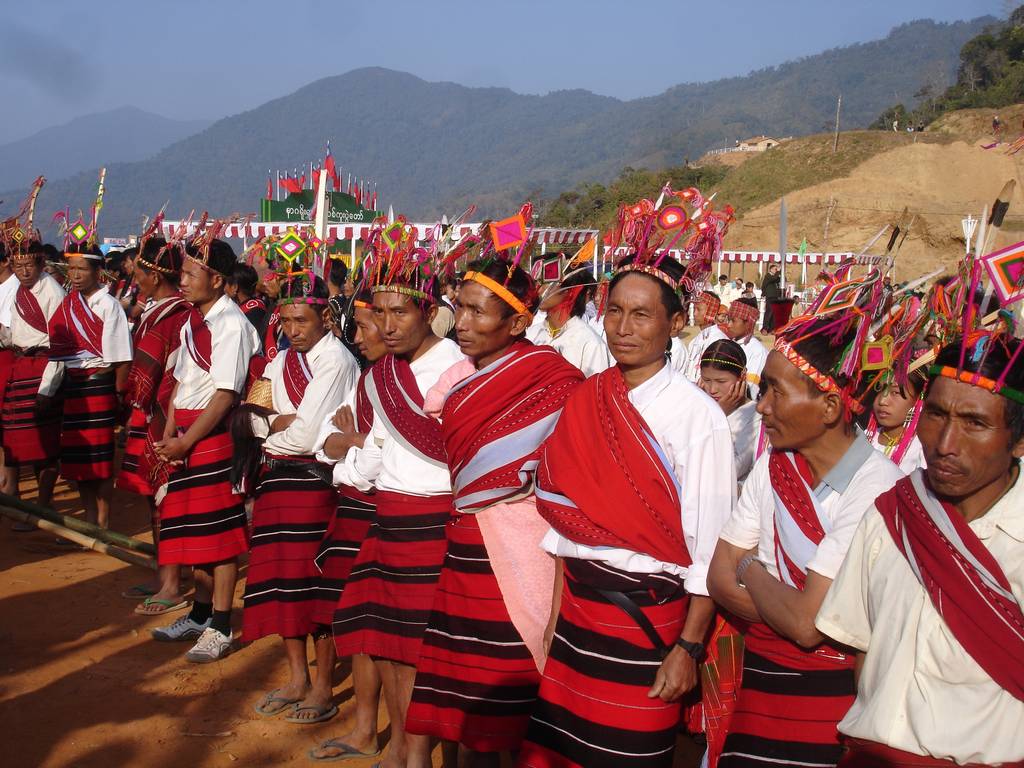
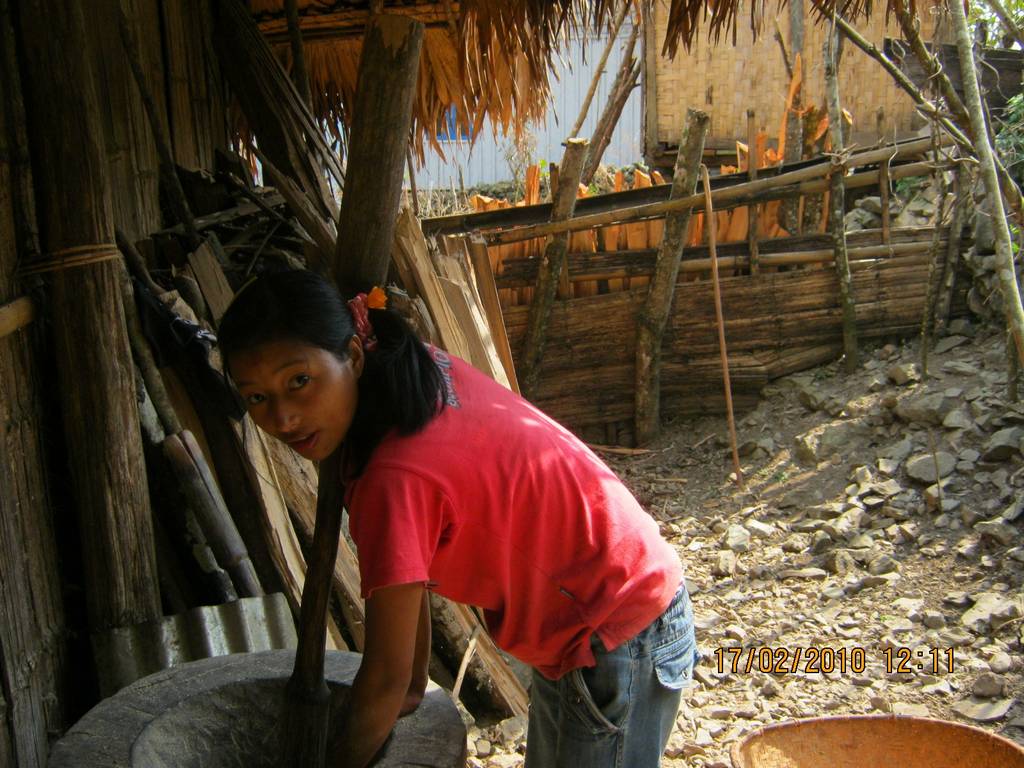
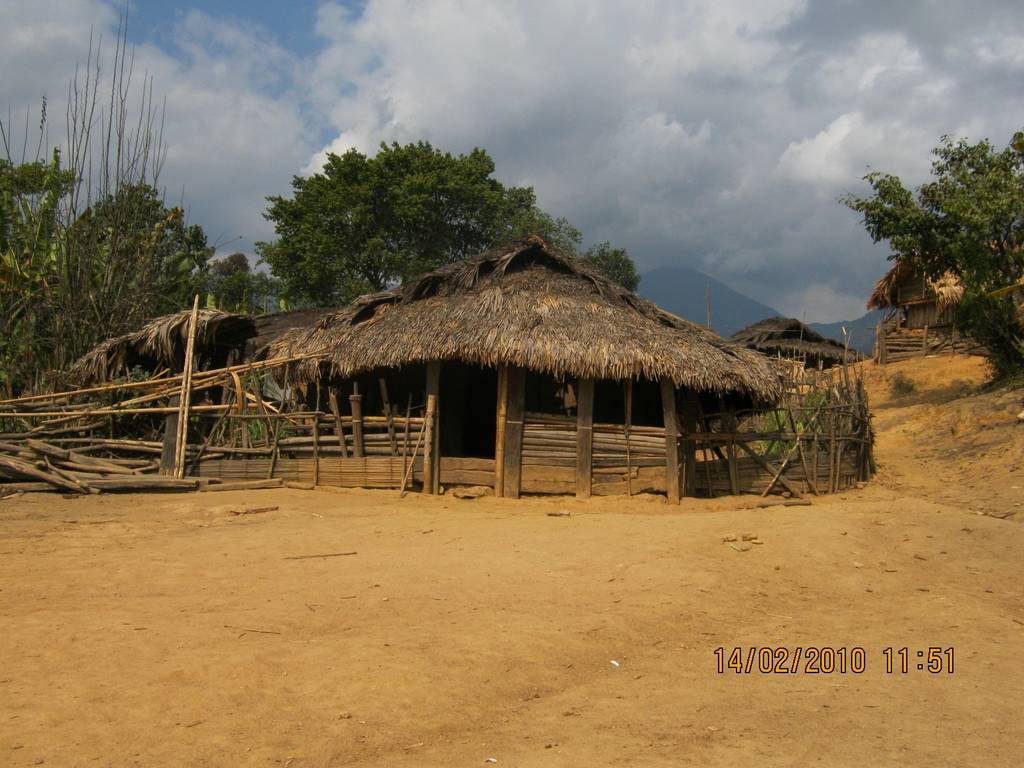
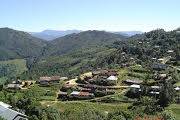
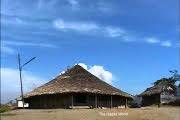
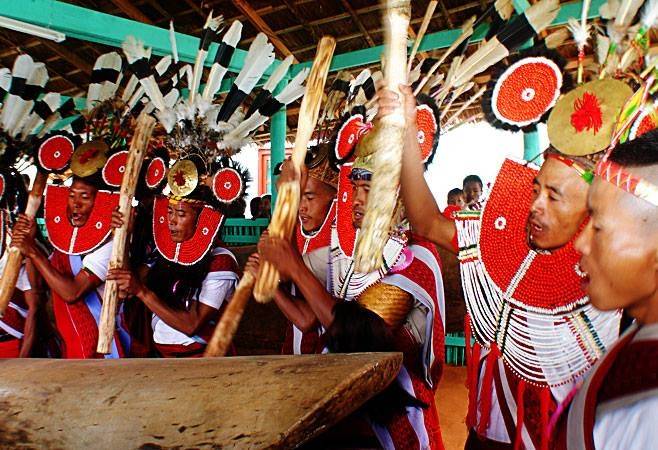
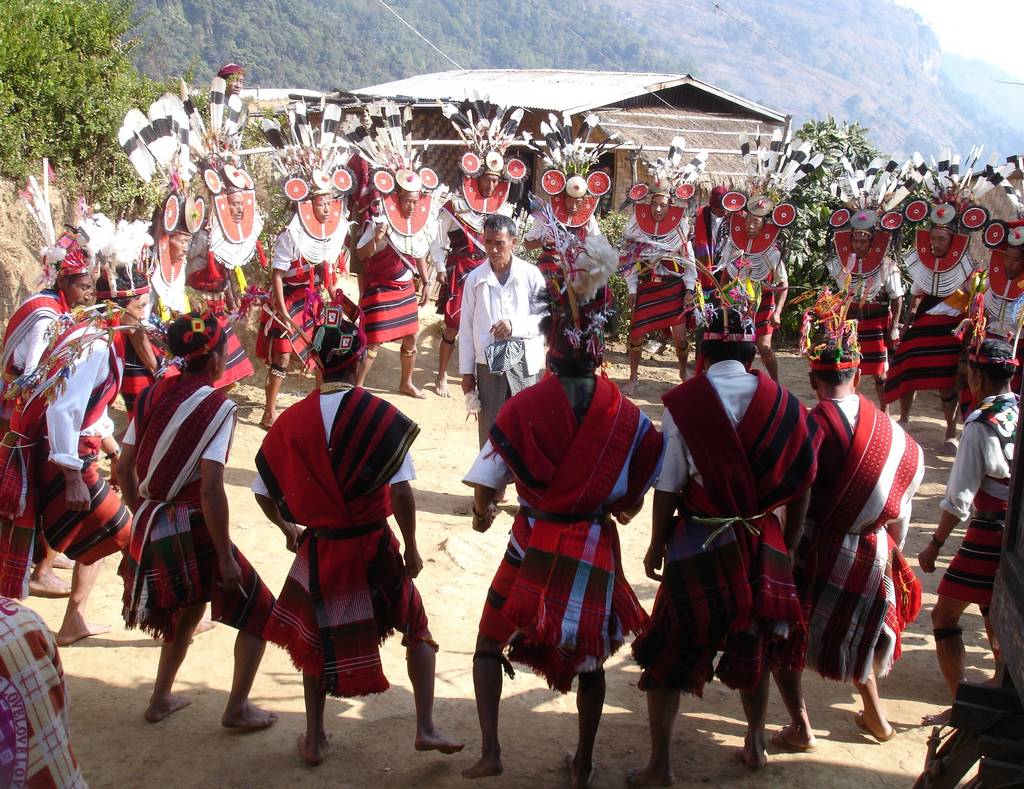
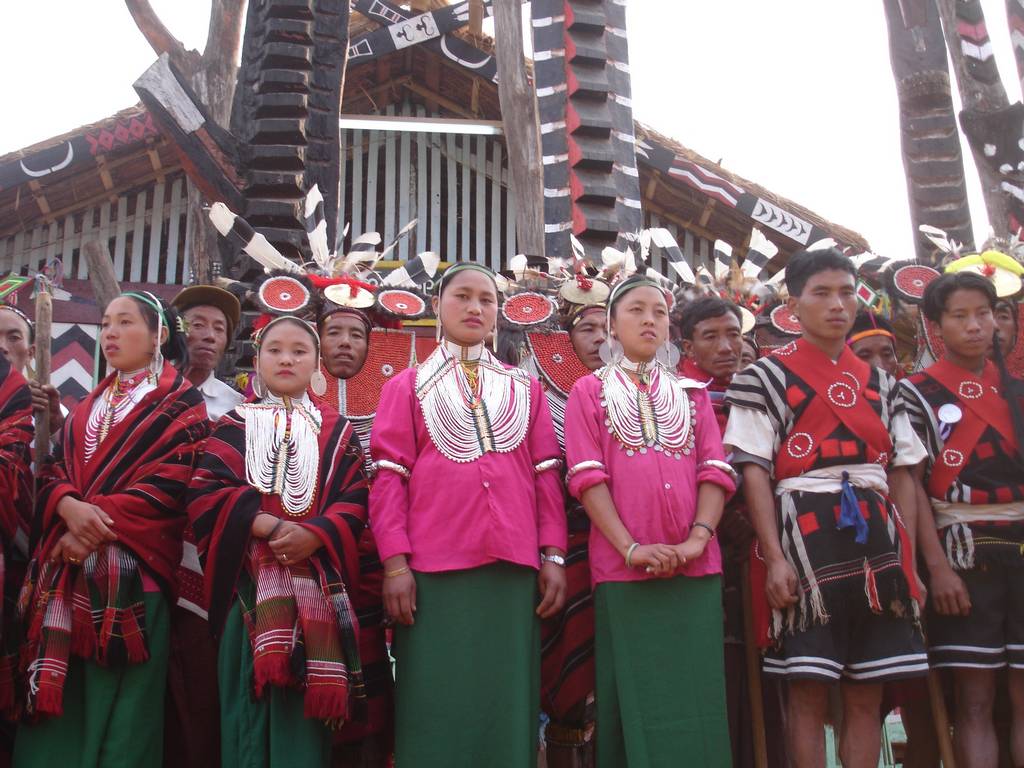
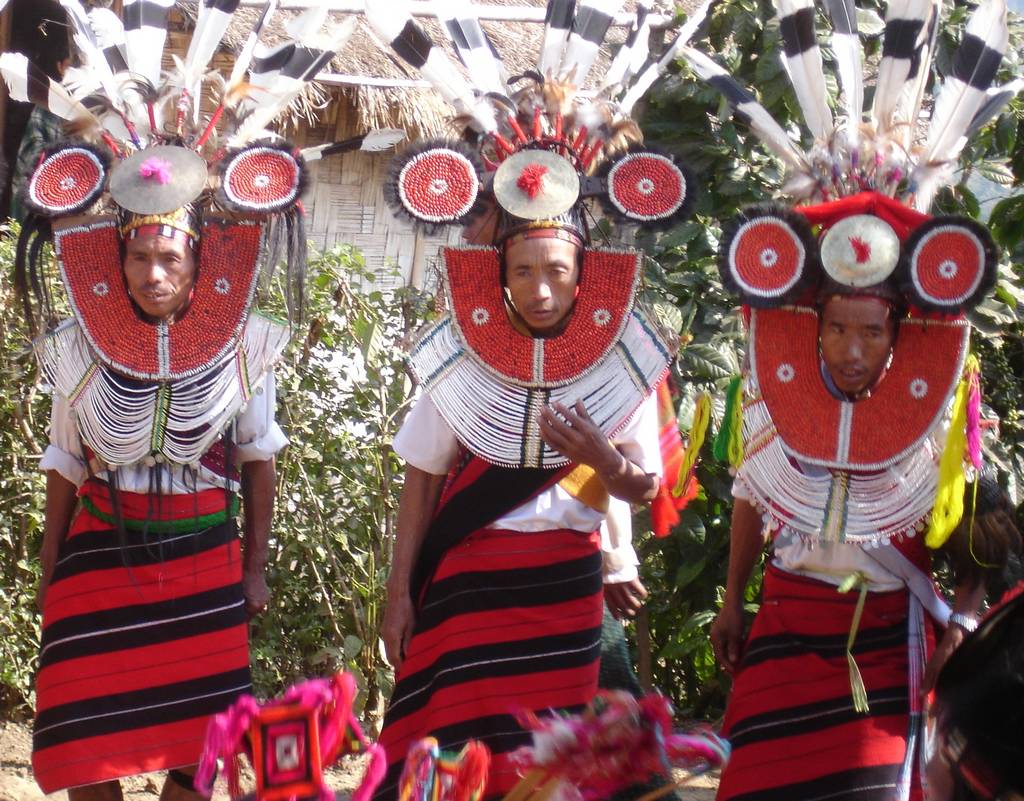
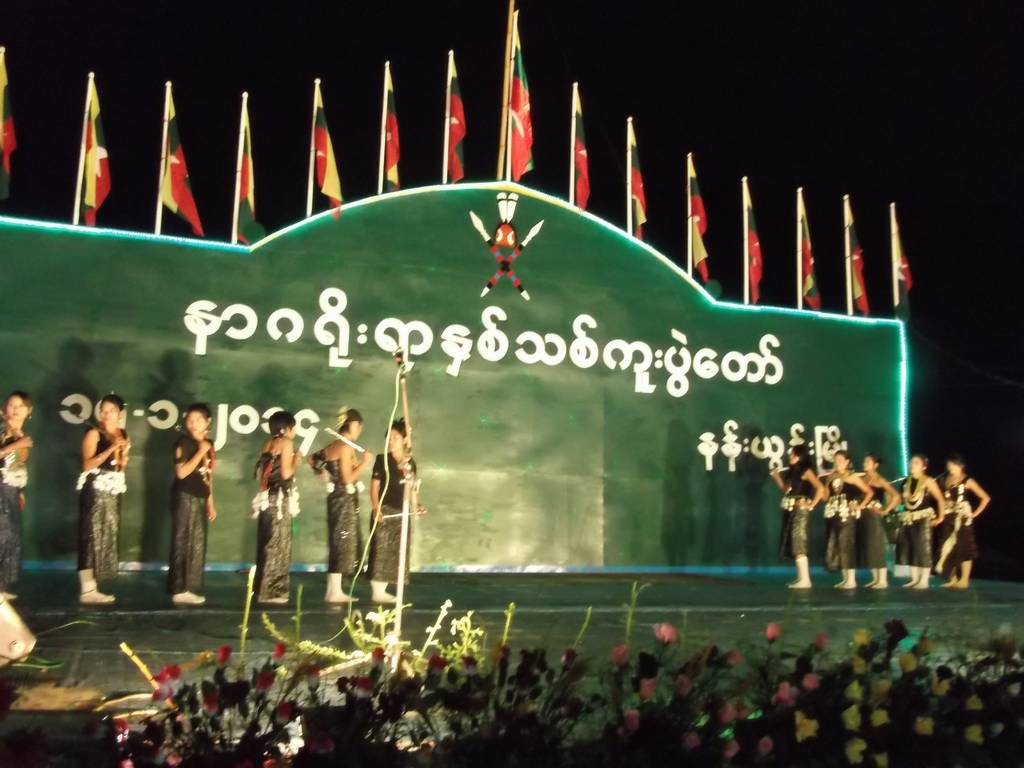
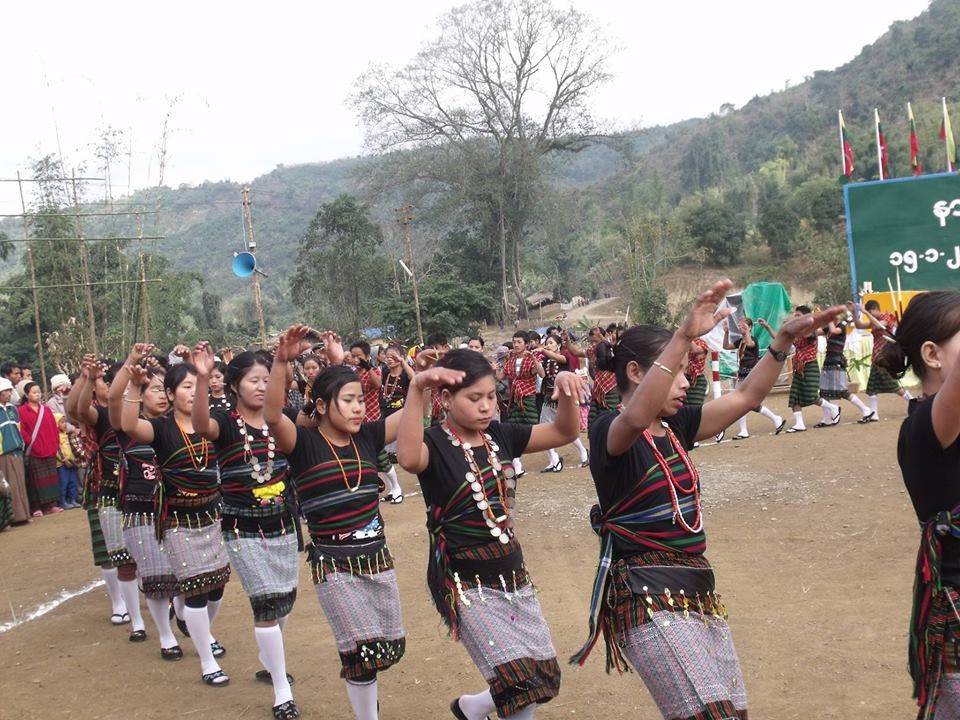
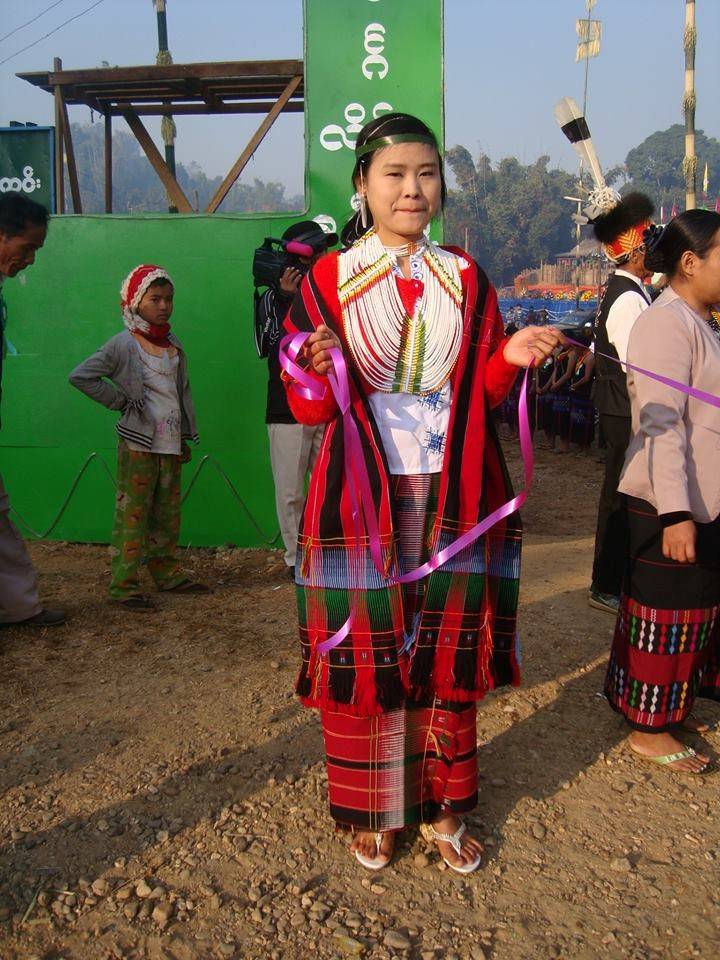


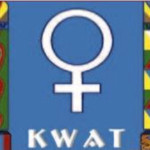
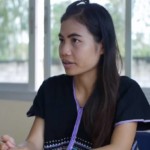
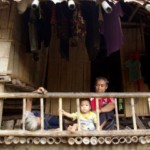
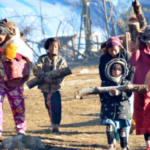
The Naga costumes and decorations are so similar to the American Navaho Indians and the people of Greenland who also originated from the Mongolian Steppes….
good speech. it made my emotion restless. with that kind of speech u can draw many youth naga to fight for our independent land.??